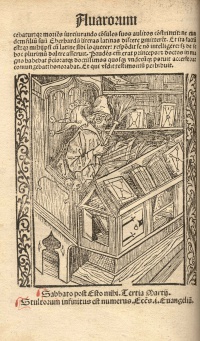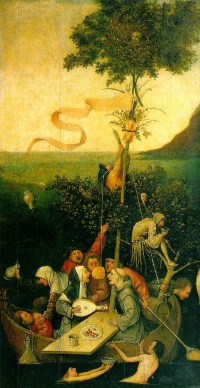Middle Ages
From The Art and Popular Culture Encyclopedia
|
"Reality [of courtly love ] at all times has been worse and more brutal than the refined aestheticism of courtesy would have it be, but also more chaste than it is represented to be by the vulgar genre which is wrongly regarded as realism."--The Autumn of the Middle Ages (1919) by Johan Huizinga "According to Jules Michelet in Satanism and Witchcraft (1862), medieval witchcraft was an act of popular rebellion against the oppression of feudalism and the Roman Catholic Church. This rebellion took the form of a secret religion inspired by paganism and fairy beliefs, organized by a woman who became its leader. The participants in the secret religion met regularly at the Witches' Sabbath and the Black Mass. Michelet's account is openly sympathetic to the sufferings of peasants and women in the Middle Ages."--Sholem Stein "In spite therefore of certain ideals of chastity presented by the Christian hagiographies, in spite of the incense burnt at the altar of Woman in romances, at tourneys and in the Courts of Love, there was never a time in the world's history in which women were more grossly insulted, more shamefully reviled, or more basely defamed than they were in the middle ages, by men of every class, beginning with the most serious writers of theology and going down to the mountebanks of the street-plays. The number of anecdotes, trivial or obscene, that drag women in the dirt is simply infinite…"--Vergil in the Middle Ages (1872) by Domenico Comparetti |

Illustration:"Hell" detail from Hieronymus Bosch's The Garden of Earthly Delights (c. 1504)
|
Related e |
|
Featured: |
The Middle Ages (adjectival form: medieval, mediaeval or mediæval) is a periodization of European history, encompassing the period from the 5th century to the 15th century. The Middle Ages follows the fall of the Western Roman Empire in 476 and precedes the Early Modern Era. It is the middle period of a three-period division of Western history: Classical, Medieval and Modern. The term "Middle Ages" first appears in Latin in the 15th century and reflects the view that this period was a deviation from the path of classical learning, a path that was later reconnected by Renaissance scholarship.
In the Early Middle Ages the trends of the Late Antiquity (depopulation, deurbanization, and increased barbarian invasion) continued. North Africa and the Middle East, once part of the Eastern Roman Empire, became Islamic. Later in the period, the establishment of the feudal system allowed a move away from subsistence agriculture. There was sustained urbanization in Northern and Western Europe.
During the High Middle Ages (c. 1000–1300), Christian-oriented art and architecture flourished and Crusades were mounted to recapture the Holy Land from Muslim control. The influence of the emerging nation-state was tempered by the ideal of an international Christendom. The codes of chivalry and courtly love set rules for proper behavior, while the Scholastic philosophers attempted to reconcile faith and reason. Outstanding achievement in this period includes the Code of Justinian, the mathematics of Fibonacci and Oresme, the philosophy of Thomas Aquinas, the paintings of Giotto, the poetry of Dante and Chaucer, the travels of Marco Polo, and the architecture of Gothic cathedrals such as Chartres.
Contents |
Art and architecture of the Early Middle Ages
Few large stone buildings were attempted between the Constantinian basilicas of the 4th century, and the 8th century. At this time, the establishment of churches and monasteries, and a comparative political stability, brought about the development of a form of stone architecture loosely based upon Roman forms and hence later named Romanesque. Where available, Roman brick and stone buildings were recycled for their materials. From the fairly tentative beginnings known as the First Romanesque, the style flourished and spread across Europe in a remarkably homogeneous form. The features are massive stone walls, openings topped by semi-circular arches, small windows, and, particularly in France, arched stone vaults and arrows
In the decorative arts, Celtic and Germanic barbarian forms were absorbed into Christian art, although the central impulse remained Roman and Byzantine. High quality jewellery and religious imagery were produced throughout Western Europe; Charlemagne and other monarchs provided patronage for religious artworks such as reliquaries and books. Some of the principal artworks of the age were the fabulous Illuminated manuscripts produced by monks on vellum, using gold, silver, and precious pigments to illustrate biblical narratives. Early examples include the Book of Kells and many Carolingian and Ottonian Frankish manuscripts.
Science and technology of the High Middle Ages
During the early Middle Ages and the Islamic Golden Age, Islamic philosophy, science, and technology were more advanced than in Western Europe. Islamic scholars both preserved and built upon earlier Ancient Greek and Roman traditions and also added their own inventions and innovations. Islamic al-Andalus passed much of this on to Europe (see Islamic contributions to Medieval Europe). The replacement of Roman numerals with the decimal positional number system and the invention of algebra allowed more advanced mathematics. Another consequence was that the Latin-speaking world regained access to lost classical literature and philosophy. Latin translations of the 12th century fed a passion for Aristotelian philosophy and Islamic science that is frequently referred to as the Renaissance of the 12th century. Meanwhile, trade grew throughout Europe as the dangers of travel were reduced, and steady economic growth resumed. Cathedral schools and monasteries ceased to be the sole sources of education in the 11th century when universities were established in major European cities. Literacy became available to a wider class of people, and there were major advances in art, sculpture, music, and architecture. Large cathedrals were built across Europe, first in the Romanesque, and later in the more decorative Gothic style.
During the 12th and 13th century in Europe, there was a radical change in the rate of new inventions, innovations in the ways of managing traditional means of production, and economic growth. The period saw major technological advances, including the invention of cannon, spectacles, and artesian wells, and the cross-cultural introduction of gunpowder, silk, the compass, and the astrolabe from the east. There were also great improvements to ships and the clock. The latter advances made possible the dawn of the Age of Exploration. At the same time, huge numbers of Greek and Arabic works on medicine and the sciences were translated and distributed throughout Europe. Aristotle especially became very important, his rational and logical approach to knowledge influencing the scholars at the newly forming universities which were absorbing and disseminating the new knowledge during the 12th Century Renaissance.
Philosophy
Culture
The Middle Ages (adjectival form: medieval, mediaeval or mediæval) is a periodization of European history, encompassing the period from the 5th century to the 15th century. The Middle Ages follows the fall of the Western Roman Empire in 476 and precedes the Early Modern Era. It is the middle period of a three-period division of Western history: Classical, Medieval and Modern. The term "Middle Ages" first appears in Latin in the 15th century and reflects the view that this period was a deviation from the path of classical learning, a path that was later reconnected by Renaissance scholarship.
Culture
- Allegory in the Middle Ages
- Eros in the Middle Ages
- Depiction of the Middle Ages in popular culture
- Medieval art
- Medieval architecture
- Medieval cuisine
- Medieval dance
- Medieval literature
- Medieval music
- Medieval philosophy
- Medieval satire
- Medieval theatre
- Outline of medieval history
- Venus in the Middle Ages
- Medieval instruments of torture
See also
- Black Death in medieval culture
- History of culture
- Middle Ages
- Medieval archaeology
- History of popular culture
- Dark Ages (historiography)
- Medievalism
- Medieval studies
- Middle Ages in history
References
- Medieval Popular Culture : Problems of Belief and Perception (1990) by Aron Gurevich, Peter Burke, Ruth Finnegan
- The Medieval Underworld (1979) is a book by Andrew McCall


.png)

